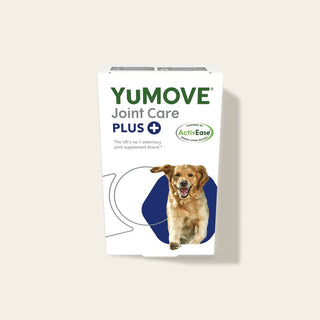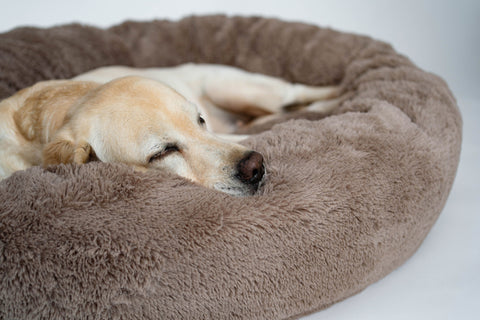

Home exercises that can help your stiff dog
If your dog has stiff joints, as well as trying YuMOVE joint supplements for dogs, it can be helpful for your dog to receive some physiotherapy from a qualified practitioner.
Here, Veterinary Physiotherapist Kathryn Hall, who runs Animotion, shares her professional insights on the benefits of canine physiotherapy and how exercises recommended by your pet physio may help your dog at home.
"You must not try these exercises without first receiving guidance from a veterinary physiotherapist. Otherwise, you risk doing more harm than good. Doing these exercises without guidance from a qualified physiotherapist can cause harm to your dog as each case is different and in some instances these exercises may not be suitable. These are just examples of some of the exercises a physiotherapist may recommend you conduct at home and to give you an insight as to how they may help an older stiffer dog"
Over to you, Kathryn!
What are the benefits of physiotherapy for dogs?
There are so many! For a dog with stiff joints, it can help increase the range of motion and flexibility, reduce stress and anxiety, and improve general mood. Exercises, massage, stretching and electrotherapies can help all dogs with stiff joints to be more comfortable.
Can I give my dog physiotherapy at home?
Physiotherapy should always be performed by a qualified, insured physiotherapist. However, your physiotherapist may give you certain remedial exercises that you can perform at home. For example, I would treat a dog in a session of physiotherapy using electrotherapies, manual therapies and remedial exercises, and then provide the owner with a plan of some remedial exercises they can perform at home.
If done correctly, physiotherapy at home can have an extremely positive effect on your dog. But if you do the exercises in the wrong way or do too many repetitions, for example, you won’t be helping your dog at all.
What kinds of remedial exercises can I give my dog?
There are many exercises that can be recommended. However, six types are most often recommended. Here are details of the different types, along with their benefits and risks associated with carrying them out without the support of a qualified veterinary physiotherapist.
1. Slow lead walking
Slow walking on a lead is a great way for a dog with stiff joints to build muscle mass. When a dog trots, they have a shorter stance phase, meaning there paws are in contact with the ground for less time. This makes it a lot easier for a dog to compensate and offload weight to another limb in trot, reducing weight bearing and therefore muscle strength. Getting a dog to walk slowly will increase the stance phase of each limb, increasing more even weight bearing on each leg and consequently increasing the strength of the muscles.
Another important thing to note when walking a dog with stiffness is that you want to reduce excessive exercise. Little and often is better than one big walk in the day. For example, instead of one 45-minute walk, you could split that into two or three shorter walks (around 15 minutes long). Your dog will feel less stiff as they get up and move frequently, rather than lying down for extended periods. This will help with circulation and hyaluronic acid production within the joint.
Slow lead walking is often recommended in dogs with stiff joints and although a very simple exercise, I would recommend getting guidance from your veterinary physiotherapist as to how often and long is appropriate for your dog as each case is different.
2. Passive Range Of Motion exercises

Passive Range of Motion – or PROM – is the range of motion of a joint, performed without muscle contraction, using an external force (such as a therapist). This is essentially where your dog lies down, and you move their legs for them.
The benefit of these exercises is that your dog’s joints are being moved without using any energy. If your dog has stiff joints, it helps to maintain and increase movement and flexibility in the joint. It also helps the joint to produce the synovial fluid that acts as cushioning and as a shock absorber for your dog. The easiest way to do this exercise is to get your dog to lie on one side, isolate the joint and gently flex and extend the limb within its natural range of motion.
With PROM exercises, it’s vital to receive instruction from a veterinary physiotherapist first, or you could move the limb too fast or hold it at the wrong angle. Please don’t have a go and hope for the best. Get professional advice before you start.
3. Static weight shifts
If a dog has stiff joints, they will often compensate. For example, if the stiffness is in the dog’s hind legs, it will front load, putting more weight on its front legs and putting these joints under more strain. Static weight shifts are a simple yet effective exercise, which helps to encourage more even weight bearing and, therefore muscle mass, helping reduce uneven forces on different joints and keep the joint more supported as the dog gets older.
It's recommended you have two people for this exercise. With the dog standing square, one person supports the dog at the front by the shoulders, while the other supports the dog with one hand on each hip joint. The next step depends on what weight shifts you’ve been recommended to target which area. For example, if your physiotherapist recommended hind weight shifts, then the person supporting the hips would very gently move the dog to one side, back to the middle, and then to the other side. This is a very subtle movement that should not make the dog move its leg but instead just bear more weight on to one side. It’s similar to when you’re standing with both feet on the ground, shifting your weight from one foot to the other.
As before, you must have precise instructions from your veterinary physiotherapist on how to carry out these exercises properly. If you make your movements too swift, you won’t be producing the slow, intense movement that will help to increase your dog’s muscle strength. Different dogs will also need very different amounts of exercise. The number of reps recommend will also vary massively depending on the case.
4. Sit to stand
This is the canine equivalent of a squat. The idea is to help your dog to build up the muscles around their hip and knee joints in a slow and controlled way.
If you think of your dog’s movement when they chase a ball or jump up high, they will be flexing and extending their back legs to the maximum extent. With this exercise, you’re allowing your dog to strengthen their muscles but within their own happy range of motion.
Essentially, you ask your dog to sit, then stand. It’s a simple exercise, but your dog needs to stand up straight – in what we call the ‘sagittal plane’. This means standing up without bending over to one side, which your dog might tend to do in order to compensate for stiff knee or hip joints. For example, if your dog always sits or lies to one side this could be a sign that it’s uncomfortable for them to lie on the opposite leg.
Although this is a straightforward exercise, you will need to ask your veterinary physiotherapist to advise whether it’s suitable for your dog and, if so, to let you know the correct number of repetitions.
5. Cavaletti poles
Often, when a dog is stiff, they have a reduced range of motion, meaning their stride length is reduced. An easy way to see if this is the case is by checking that when their front paw, for example, leaves the ground, their left back paw goes straight into the spot that the front paw has just occupied. If a dog was walking on sand, the back paw would step right into the paw print left by the front paw.
When a dog has stiff joints, they have a reduced range of motion. Their back paws don’t have the flexibility to reach as far forward. Cavaletti pole exercises help because your dog has to flex and extend their legs to step over the poles on the ground. By lifting their leg higher, they increase their flexor and extender muscles and their range of motion.
Your veterinary physiotherapist can advise you on the right number of repetitions and the correct spacing between the poles, according to the condition and size of your dog. If you have the wrong spacing, your dog could stand on the pole and slip. Also, if your dog has a really low flight arc and is unable to lift their leg very high at all, ground poles may not be appropriate.
6. Weaving, circles and figures of eight
You can do these exercises in your house or, depending on the weather, in your garden. The idea is to encourage your dog to walk in a nice big circle or figure of eight, or to walk between weaving poles. These exercises help to strengthen your dog’s muscles and increase their range of motion.
When your dog walks in a circle, they increase the weight load on their inside legs, helping increase muscle strength. As well as this, their outside legs have to stretch further than normal to get around the circle, and therefore increase so you target both sides of the dog.
Before attempting these exercises, ask for your veterinary physiotherapist’s advice. They’ll suggest different numbers of repetitions depending on your dog’s age and condition. Also, if your dog has very stiff joints, walking in circles would not be recommended as this could put additional pressure on their joints.
How can I find a good veterinary physiotherapist?
Ask your vet for a recommendation or check out these associations that represent qualified veterinary physiotherapists:
- The National Association of Veterinary Physiotherapists (NAVP)
- The Register of Animal Musculoskeletal Practitioners (RAMP)
- The Association of Physiotherapists in Animal Therapy (ACPAT)
- The Institute of Registered Veterinary & Animal Physiotherapists (IRVAP)
Also, bear in mind that any veterinary physiotherapist may need consent from your vet before starting any therapy. This is to ensure that the physiotherapist knows your dog’s medical history and can take any existing conditions into account.
Once you’ve found someone who’s qualified, and is recommended by your vet, it’s a question of meeting up with them to see how you and your dog get along with them.

Kathryn Hall BS (Hons), PgDIP Veterinary physiotherapy, NAVP.



